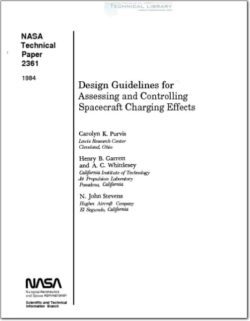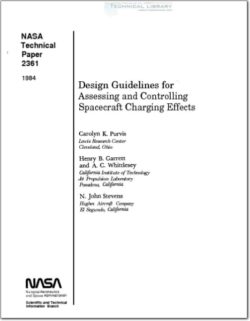NASA-TP-2361

- Version
- 431 Downloads
- 2.58 MB File Size
- 1 File Count
- May 18, 2016 Create Date
- May 18, 2016 Last Updated
Design Guidelines for Assessing and Controlling Spacecraft Charging Effects

Spacecraft charging is defined as those phenomena
associated with the buildup of charge on exposed external
surfaces of geosynchronous spacecraft. This surface
charging results from spacecraft encounter with a
geomagnetic substorrn environment-a plasma with
particle energies from 1 to 50 keV.
Two types of spacecraft charging will be considered.
The first, called absolute charging, occurs when the entire
spacecraft potential relative to the ambient space plasma
is changed uniformly by the encounter with the charging
environment. The second type. called differential charg-
ing. occurs when parts of the spacecraft are charged to
different negative potentials relative to each other. In this
type of charging, strong local electric fields may exist.
The designer must recognize the importance of mission
role and spacecraft configuration in evaluating absolute
and differential charging effects. The buildup of large
potentials on spacecraft relative to the ambient plasma is
not, of itself, a serious electrostatic discharge (ESD)
design concern. However, such charging enhances sur-
face contamination, which degrades thermal properties.
It also compromises scientific missions ‘seeking to
measure properties of the space environment. Spacecraft
systems referenced to structure ground are not affected
by a uniformly charged spacecraft. However, spacecraft
surfaces are not uniform in their material properties,
surfaces will be either shaded or sunlit, and the ambient
fluxes may be anisotropic. These and other charging
effects can produce potential differences between
spacecraft surfaces or between spacecraft surfaces and
spacecraft ground. When a breakdown threshold is ex-
ceeded, an electrostatic discharge can occur. The
transient generated by this discharge can couple into the
spacecraft electronics and cause upsets ranging from
logic switching to complete system failure. Discharges
can also cause long-term degradation of exterior surface
coatings and enhance contamination of surfaces.
| File | Action |
|---|---|
| NASA-TP-2361 Design Guidelines for Assessing and Controlling Spacecraft Charging Effects.pdf | Download |

Comment On This Post